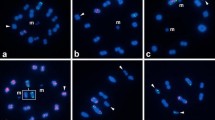Abstract
The polytene chromosome puffing patterns of Drosophila guanche were established and compared with those of Drosophila subobscura. A total of 150 loci, active in some of the 17 developmental stages studied, were described and 23 of them were found to form the characteristic puffing pattern of D. guanche. Taking into account the number of puffs as well as the gene activity of each chromosome and the total gene activity, D. guanche seems to be less active than D. subobscura. Although both species show a degree of homology in their puffing patterns lower than that found for sibling species, the degree of homology is stronger than that between species belonging to the same group but to different subgroups. Thus, D. guanche and D. subobscura must be considered as phylogenetically closely related species, belonging to the same subgroup.
Similar content being viewed by others
References
Ashburner M (1969a) Patterns of puffing activity in the salivary gland chromosomes of Drosophila. II. The X-chromosome puffing patterns of Drosophila melanogaster and Drosophila simulans. Chromosoma 27:47–63
Ashburner M (1969b) Patterns of puffing activity in the salivary gland chromosomes of Drosophila. III. A comparison of the autosomal puffing patterns of the sibling species Drosophila melanogaster and Drosophila simulans. Chromosoma 27:64–85
Ashburner M (1969c) On the problem of genetic similarity between sibling species puffing patterns in Drosophila melanogaster and Drosophila simulans. Am Nat 103:189–191
Ashburner M (1970a) Function and structure of polytene chromosomes during insect development. Adv Insect Physiol 7:1–95
Ashburner M (1970b) Patterns of puffing activity in the salivary gland chromosomes of Drosophila. V. Responses to environmental treatments. Chromosoma 31:356–376
Ashburner M (1972) Puffing patterns in Drosophila melanogaster and related species. In: Beermann W (ed) Results and problems in cell differentiation, vol 4. Developmental studies on giant chromosomes. Springer, New York Heidelberg Berlin, pp 101–151
Ashburner M, Bonner JJ (1979) The induction of gene activity in Drosophila by heat shock. Cell 17:241–254
Ashburner M, Lemeunier F (1972) Patterns of puffing activity in the salivary gland chromosomes of Drosophila. VII. Homology of puffing patterns on chromosome arm 3L in D. melanogaster and D. yakuba with notes on puffing in D. teissieri. Chromosoma 38:283–295
Beermann W (1956) Nuclear differentiation and functional morphology of chromosomes. Cold Spring Harbor Symp Quant Biol 21:217–232
Berendes HD (1972) The control of puffing in Drosophila hydei. In: Beermann W (ed) Results and problems in cell differentiation, vol 4. Developmental studies on giant chromosomes. Springer, Berlin Heidelberg New York, pp 181–207
Cabrera VM, González AM, Larruga JM, Gullón A (1983) Genetic distance and evolutionary relationships in the Drosophila obscura group. Evolution 37:675–689
de Frutos R, Latorre A, Pascual L (1987) Patterns of puffing activity and chromosomal polymorphism in Drosophila subobscura. IV. Position effect at the boundaries of the E12 inversion. Genetica 75:11–22
Krimbas CB, Loukas M (1980) The inversion polymorphism of Drosophila subobscura. Evol Biol 12:163–234
Kunze-Mühl E, Müller E (1958) Weitere Untersuchungen über die chromosomale Struktur und die natürlichen Strukturtypen von Drosophila subobscura Coll. Chromosoma 9:559–570
Lakovaara S, Saura A, Lankinmen P, Pohjela L, Lokki J (1976) The use of isozymes in tracing evolution and in classifying Drosophilidae. 1st Scand Symp Syst Zool Scripta 5:173–179
Moltó MD, de Frutos R, Martínez-Sebastián MJ (1987) The banding pattern of polytene chromosomes of Drosophila guanche compared with that of D. subobscura. Genetica 75:55–70
Monclús M (1976) Distribución y ecología de Drosofílidos en España. II. Especies de Drosophila de las Islas Canarias, con la descriptión de una nueva especie. Bol R Soc Esp Hist Nat Secc Biol 74:197–213
Pascual L, de Frutos R (1986) Stress response in Drosophila subobscura. I. Puff activity after heat shocks. Biol Cell 57:127–134
Pascual L, de Frutos R, Latorre A (1985) Patterns of puffing activity and chromosomal polymorphism in Drosophila subobscura. II. Puffing patterns at the prepupa stage. Genetica 66:123–138
Prevosti A (1976) Cariotipo de Drosophila guanche Monclús y Dettopsomyia nigrovittata Malloc. Bol R Soc Esp Hist Nat Secc Biol 74:215–217
Scouras ZG, Kastritsis CD (1984) Balbiani rings and puffs of the polytene chromosomes of Drosophila auraria. Chromosoma 89:96–106
Stocker AN, Kastritsis CD (1972) Developmental studies in Drosophila. III. The puffing patterns of the salivary gland chromosomes of Drosophila pseudoobscura. Chromosoma 37:139–176
Zhimulev IF, Belyaeva ES, Semeshin VF (1981) Informational content of polytene chromosome bands and puffs. CRC Crit Rev Biochem pp 303–340
Author information
Authors and Affiliations
Rights and permissions
About this article
Cite this article
Moltó, M.D., de Frutos, R. & Martínez-Sebastián, M.J. Gene activity of polytene chromosomes in Drosophila species of the obscura group. Chromosoma 96, 382–390 (1988). https://doi.org/10.1007/BF00330706
Received:
Issue Date:
DOI: https://doi.org/10.1007/BF00330706




